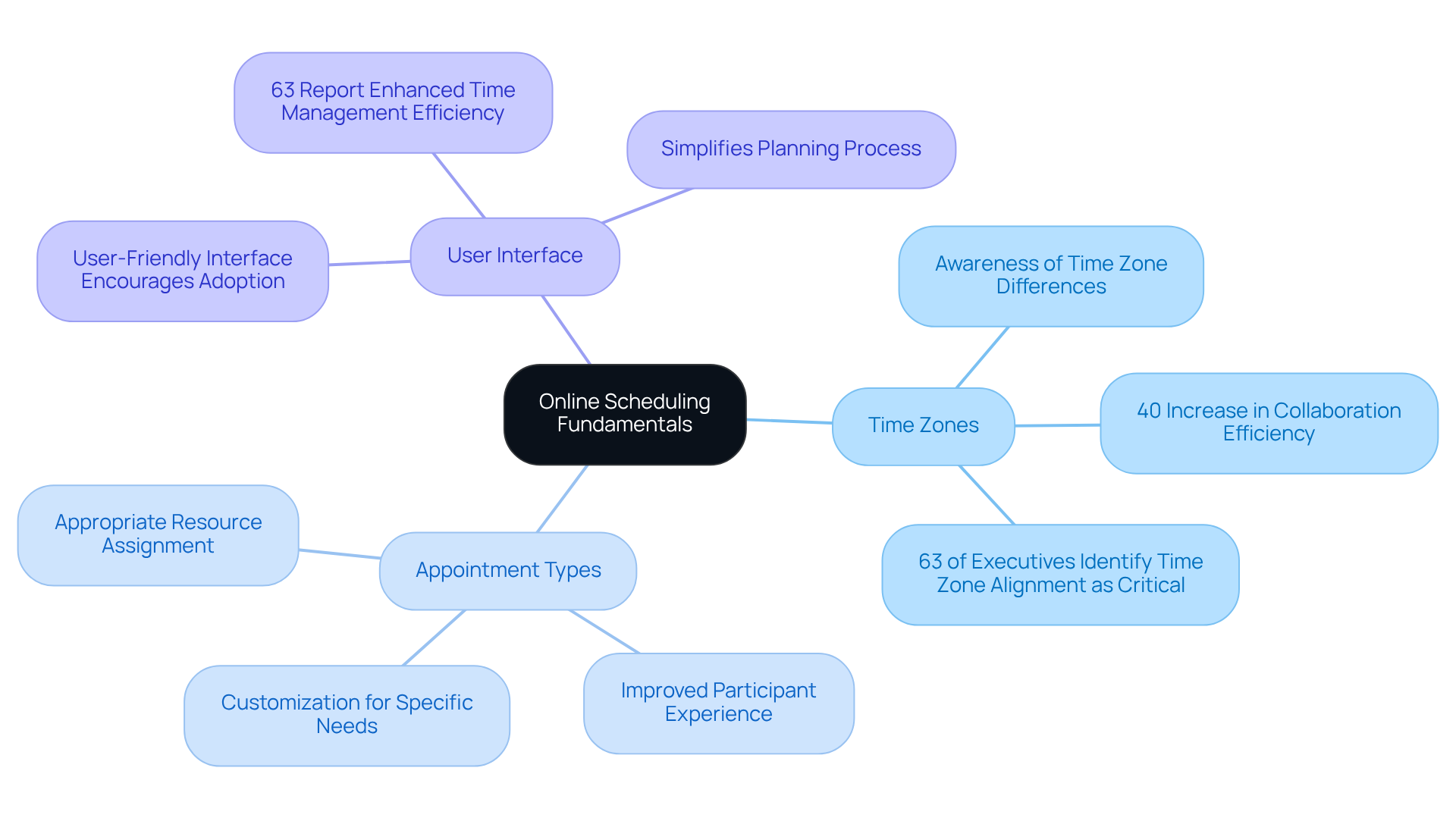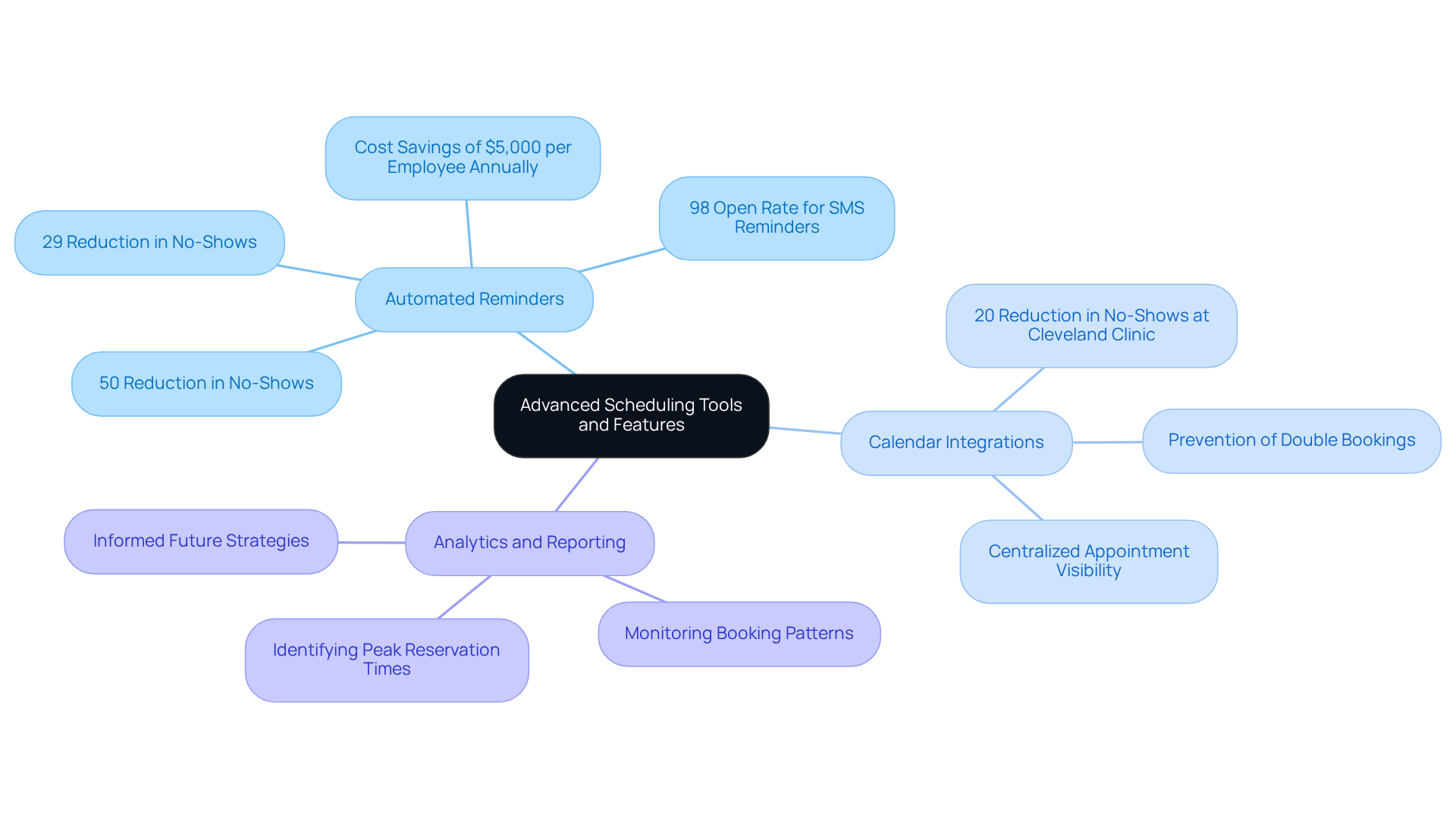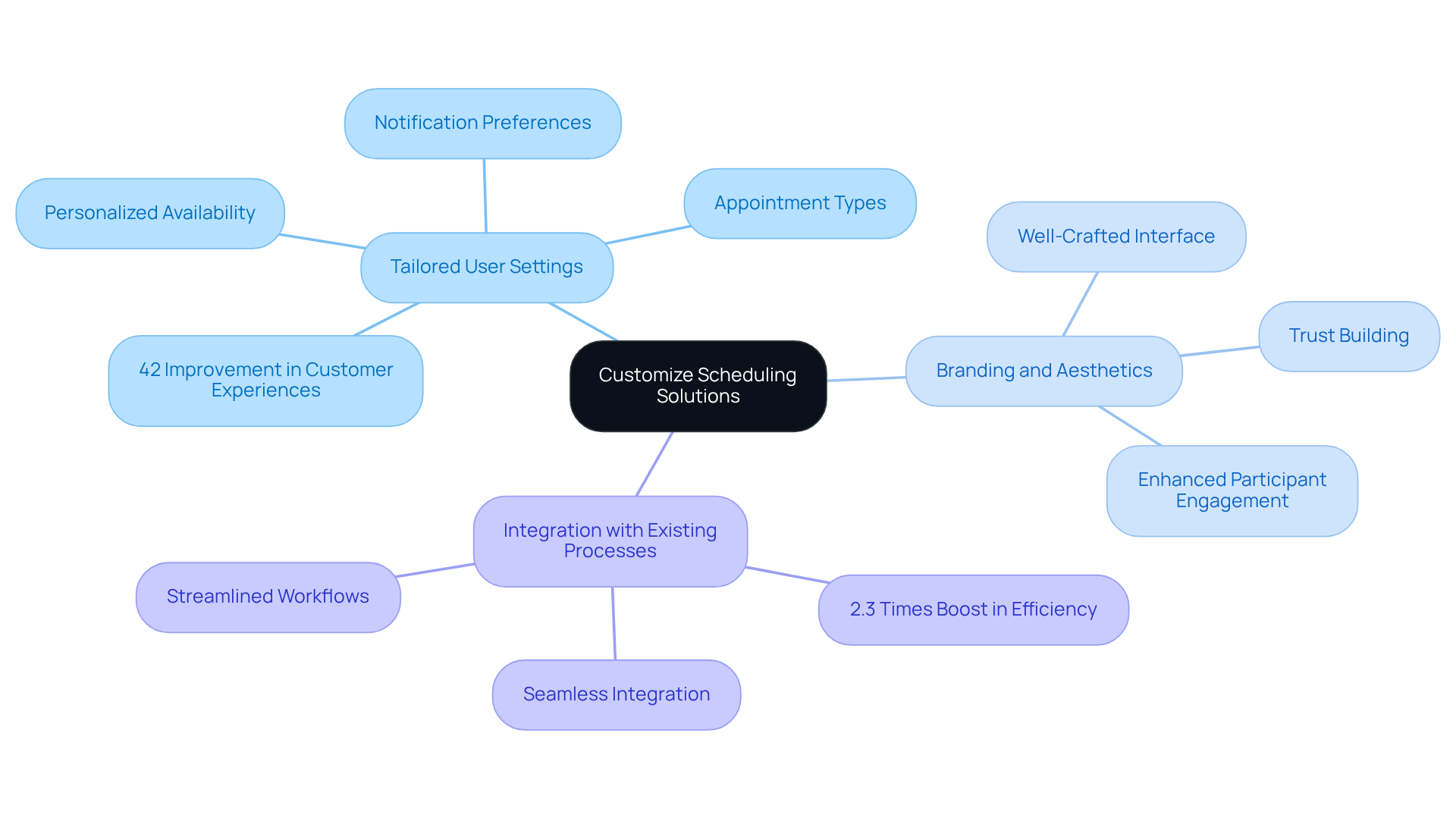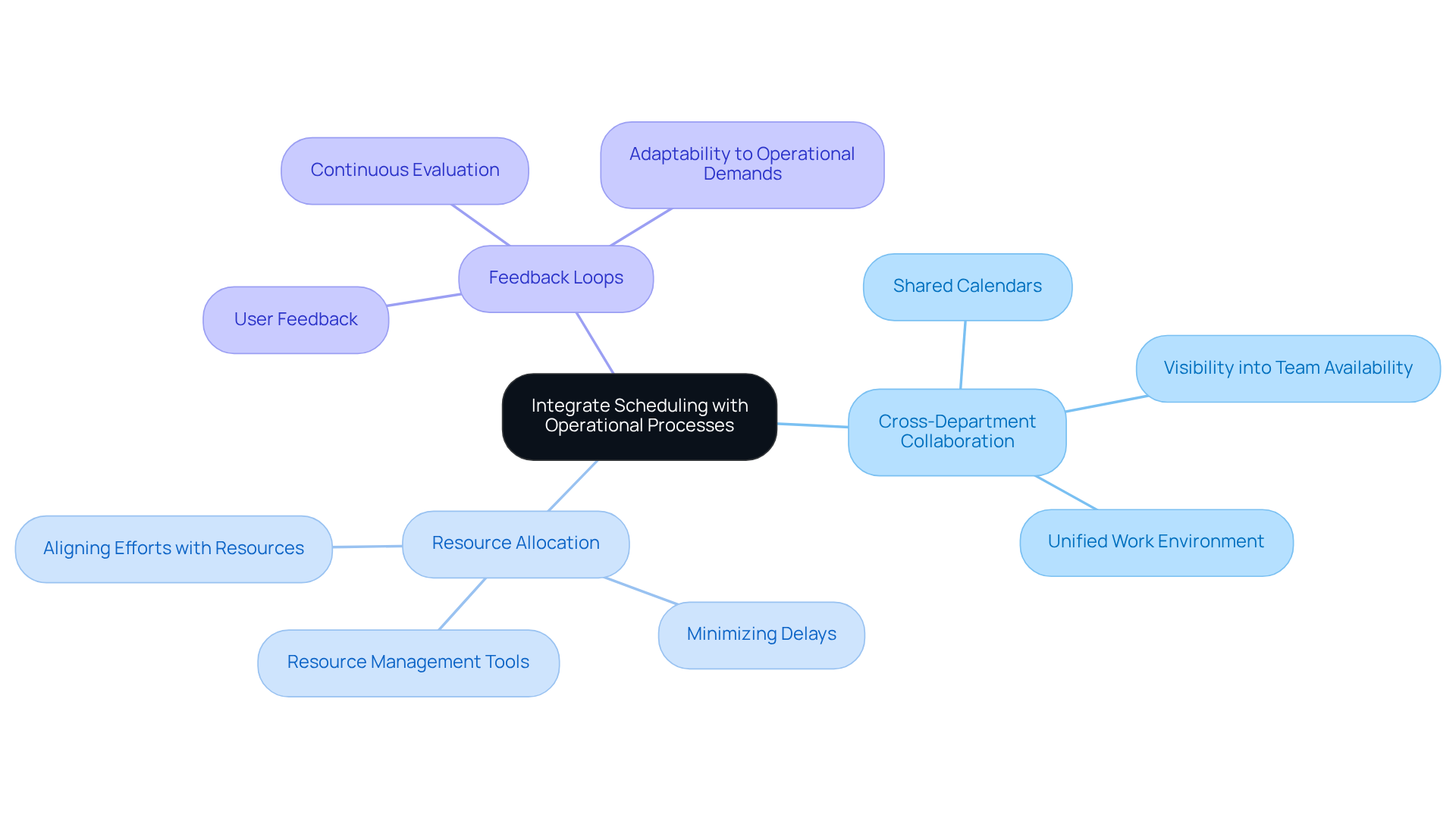4 Best Practices for Scheduling Online Free to Boost Efficiency

Overview
This article presents four best practices for online scheduling aimed at enhancing efficiency. It underscores the critical need to understand time zones, leverage advanced tools, customize solutions, and seamlessly integrate scheduling with operational processes. Evidence strongly supports that effective scheduling not only fosters collaboration but also significantly reduces no-show rates and boosts overall productivity. These improvements ultimately lead to optimal resource allocation and operational success. By adopting these practices, organizations can address communication inefficiencies and realize substantial gains in their operational workflows.
Introduction
In an increasingly interconnected world, the ability to schedule meetings efficiently is paramount; it can significantly influence an organization’s productivity. Mastering the art of online scheduling allows companies to unlock substantial benefits, ranging from improved collaboration to enhanced resource management.
Nevertheless, many organizations continue to grapple with the complexities of:
- Time zones
- Appointment types
- User interface design
This often results in missed opportunities and inefficiencies. To streamline their scheduling processes and fully capitalize on the advantages of modern scheduling tools, organizations must adopt effective strategies.
Understand the Fundamentals of Online Scheduling
To effectively leverage online scheduling, organizations must grasp its fundamental components:
-
Time Zones: Awareness of time zone differences is crucial, particularly for global teams. Utilizing tools that automatically adapt for time zones can greatly minimize planning conflicts. Research indicates that companies leveraging time zone awareness can see a 40% increase in collaboration efficiency. Additionally, 63% of executives identified time zone alignment as critical for achieving successful project outcomes.
-
Appointment Types: Distinguishing among different appointment types—such as one-on-one meetings, group sessions, or consultations—is essential to customize the timing process to specific needs. This customization not only improves participant experience but also ensures that the appropriate resources are assigned for each meeting type.
-
User Interface: A user-friendly interface is vital for encouraging adoption among team members. An intuitive and accessible planning tool can lead to higher engagement rates. Industry leaders emphasize that a well-crafted interface simplifies the planning process, making it more available for all individuals. Moreover, 63% of entities indicated enhanced time management efficiency due to planning software, underscoring the link between user interface design and overall effectiveness.
By mastering these fundamentals, entities can establish a robust foundation for advanced planning practices, ultimately resulting in enhanced efficiency and a decrease in conflicts related to scheduling online free. For instance, GlobalInnovate improved productivity by addressing time zone challenges, while GitLab’s asynchronous communication model has demonstrated significant increases in team satisfaction and productivity. Ineffective planning can result in revenue losses of up to 30%, highlighting the financial consequences of inadequate planning methods.

Leverage Advanced Scheduling Tools and Features
To address the challenges of communication inefficiencies in scheduling online free, organizations must utilize advanced tools and features that enhance operational efficiency.
-
Automated Reminders: Implementing automated reminders through email or SMS can significantly reduce no-shows. Studies indicate that such systems can decrease missed appointments by up to 50%. Moreover, research shows that automated reminder systems can reduce no-show rates by 29%, thereby enhancing attendance rates and operational efficiency. By utilizing these systems, practices can save as much as $5,000 per employee annually, underscoring their cost-effectiveness.
-
Calendar Integrations: Employing planning applications that seamlessly connect with existing calendars, such as Google Calendar and Outlook, is essential. These integrations help prevent double bookings and ensure that all appointments are visible in one centralized location. For instance, Cleveland Clinic effectively reduced no-show rates by 20% through efficient reminder planning, illustrating the benefits of combining automated systems with calendar tools.
-
Analytics and Reporting: Utilizing analytics capabilities allows companies to monitor booking patterns, identify peak reservation times, and assess the efficiency of their planning methods. This data-driven approach can inform future strategies, leading to more efficient planning and improved resource allocation.
By integrating these advanced functionalities, organizations can streamline their scheduling online free processes, enhance the experience for individuals, and ultimately increase overall efficiency.

Customize Scheduling Solutions for Your Organization
Tailoring planning solutions is essential for aligning them with the unique needs of your organization. To address communication inefficiencies, consider the following key aspects that can transform your operational efficiency:
-
Tailored User Settings: Empower users to personalize their availability, appointment types, and notification preferences. This flexibility not only enhances the planning experience but also significantly boosts productivity. As Dr. Leonard Tau highlighted, planning tools can greatly influence productivity, with 42% of companies reporting improved customer experiences after adopting such features.
-
Branding and Aesthetics: A well-crafted interface for organizing time that reflects your organization’s branding can greatly enhance participant engagement and trust. Branding experts emphasize that aesthetics play a crucial role in user perception, making it vital to create a visually appealing and cohesive experience that resonates with users.
-
Integration with Existing Processes: Ensure that your planning tool seamlessly integrates with other operational systems, such as project management or customer relationship management (CRM) platforms. This integration can streamline workflows; entities utilizing integrated platforms experience a 2.3 times boost in efficiency, showcasing the practical benefits of such customizations.
By applying these customizations, businesses can elevate user satisfaction and significantly enhance the overall efficiency of their planning practices. Explore these tailored solutions to revolutionize your organizational planning.

Integrate Scheduling with Operational Processes
To achieve optimal efficiency, organizations must seamlessly integrate scheduling online free into their operational processes.
-
Cross-Department Collaboration: Scheduling tools should promote collaboration across departments by enabling shared calendars and providing visibility into team availability. This approach fosters a unified work environment, essential for effective project execution. Notably, 64% of resource managers emphasize enhancing resource distribution and accuracy in planning, underscoring the necessity for efficient collaboration solutions.
-
Resource Allocation: By connecting planning with resource management tools, entities can ensure that the appropriate resources are designated for planned appointments. This integration minimizes delays and maximizes productivity, as teams can better align their efforts with available resources. According to the Resource Management Institute, effective resource allocation is crucial for a company’s success and can drive growth and efficiency.
-
Feedback Loops: Establishing feedback mechanisms is crucial for continuously evaluating the effectiveness of planning practices. Consistent feedback from users enables entities to make required modifications, ensuring that planning remains adaptable to operational demands. As noted by specialists, ongoing enhancement in planning practices can significantly boost overall productivity.
Integrating scheduling online free with operational processes not only streamlines workflows but also enhances overall productivity, enabling entities to respond swiftly to changing demands and improve collaboration across teams. However, organizations should be aware of common pitfalls, such as miscommunication and siloed departments, which can hinder effective integration.

Conclusion
Mastering online scheduling is crucial for organizations aiming to enhance efficiency and collaboration. Recognizing fundamental aspects such as time zones, appointment types, and user interface design allows businesses to establish effective scheduling practices. This foundational knowledge, combined with advanced tools and features like automated reminders and calendar integrations, significantly reduces no-show rates and streamlines operations.
Key insights from this article emphasize the necessity of customizing scheduling solutions to address the unique needs of each organization. Tailored user settings and aesthetic branding greatly enhance user engagement, while seamless integration with existing processes promotes better collaboration and resource allocation. Furthermore, the ability to adapt scheduling practices based on feedback ensures that organizations remain agile in a dynamic environment.
Ultimately, the importance of effective online scheduling transcends mere organization; it drives productivity, enhances team satisfaction, and supports overall business success. By prioritizing these best practices, organizations can not only improve their scheduling efficiency but also cultivate a more cohesive and responsive operational framework. Embracing these strategies is an essential step toward achieving sustainable growth and operational excellence in an increasingly digital landscape.
Frequently Asked Questions
What are the fundamental components of online scheduling?
The fundamental components of online scheduling include understanding time zones, distinguishing between different appointment types, and having a user-friendly interface.
Why is awareness of time zones important in online scheduling?
Awareness of time zones is crucial for global teams as it minimizes planning conflicts. Companies that leverage time zone awareness can see a 40% increase in collaboration efficiency, and 63% of executives consider time zone alignment critical for successful project outcomes.
How do different appointment types impact scheduling?
Distinguishing between appointment types—such as one-on-one meetings, group sessions, or consultations—allows organizations to customize the scheduling process to meet specific needs, improving participant experience and ensuring appropriate resource allocation.
What role does user interface play in online scheduling?
A user-friendly interface is vital for encouraging team members’ adoption of scheduling tools. An intuitive planning tool can lead to higher engagement rates, and 63% of entities reported enhanced time management efficiency due to effective planning software.
What are the benefits of mastering online scheduling fundamentals?
Mastering the fundamentals of online scheduling helps establish a robust foundation for advanced planning practices, resulting in enhanced efficiency and reduced scheduling conflicts. For example, GlobalInnovate improved productivity by addressing time zone challenges.
What are the consequences of ineffective planning in online scheduling?
Ineffective planning can lead to significant revenue losses, with potential losses of up to 30%, highlighting the financial impact of inadequate scheduling methods.
